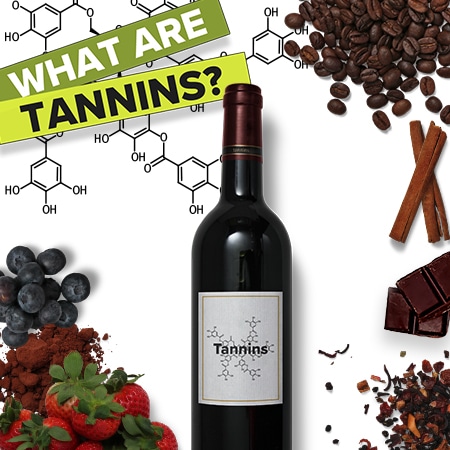Tannins: What are they and what are their health benefits?
If you enjoy wine, you may have heard of tannins. Tannins play a specific role in the texture and taste of wine. Did you know that there are plenty of other benefits that tannins can offer you than just an enjoyable glass of wine? 
This article will focus on everything you need to know about tannins — the good, the bad, and everything in between.
So, first…
What are tannins?
Tannins are complex molecules found in phenolic acids. They are a polyphenol derived from plants. These compounds are found in the bark, root, leaf, flower, fruit, and seed of plants.
The tannins help to protect plants from fungi and bacteria. There are high concentrations of tannins in unripened fruits and leaves to protect the fruit and seeds from animals. That allows the seeds and fruits to become more mature so they can replicate. The tannins give them a very bitter taste that prevents them from being eaten.
Eating foods high in tannins can offer the same protection to our bodies that they do to the plants they’re coming from. These large molecules easily bond with proteins, starches, cellulose, and other minerals. This makes them great for helping to protect these molecules so they’re safely delivered throughout your body to maintain your health.
You can easily tell when tannins are in a food or beverage. Wine is the most common place we hear about tannins. Red wines that are high in tannins will be dry and more bitter. Grapes themselves have a high quantity of tannins. But wine that is aged in wooden barrels has even higher tannin counts because it soaks in additional tannins from the wood. Dark teas are another place you can experience the pucker that tannins cause.
Health benefits of tannins
Tannins contain a plethora of health benefits. They also help improve multiple body systems and health conditions.
Tannins are high in antioxidants which help to alleviate the oxidative stress our bodies experience in our current day and age.
One of the major benefits of tannins is that they have anti-inflammatory properties. They can be used to help improve systemic inflammation but they can also be used topically in salves to improve wound healing times.
Tannins contain antibacterial and antimicrobial effects that are so strong that they are currently being studied as an alternative to antibiotics for urinary tract infections (UTIs).
- pylori is a common gastrointestinal infection that causes peptic ulcers. This is another condition that is traditionally treated with antibiotics. However, H. pylori are becoming noticeably more antibiotic resistant. The use of tannins in a study showed that tannins are a suitable treatment for H. pylori infections instead of antibiotics.
Tannins also appear to help your body utilize and dispose of cholesterols easier. A study on rats showed that using tannin-based treatments allowed the rats to use the healthy parts of cholesterol and excrete the unnecessary parts more effectively than without treatment. This helped them to regulate their cholesterol and triglyceride levels.
When used as a pretreatment, tannins significantly improved the effects of treatment in rats experiencing hemorrhagic shock. Compared to the control group, rats receiving tannic acid pretreatment improved arterial pressure and heart rate bringing them to homeostasis much quicker.
How to get more tannins in your diet
So if you aren’t sensitive to tannins, you may be wanting to get their benefits for yourself. Well, you’re in luck! There are several foods you can add to your diet to get more tannins and, therefore, better health.
Beverages high in tannins
Beverages are the most common place people know they can access tannins. Red wine and dark teas are some of the most commonly known sources of tannins, but they aren’t the only ones.
You can also find tannins in:
- Cranberry juice
- Grape juice
- Apple juice
- Apple cider
- Beer
- Pomegranate juice
Foods high in tannins
Since we know wine and tea are where we get a lot of tannins, we sometimes forget that you can get them from food too. So here is a list of foods you can start incorporating into your diet to experience the benefits of tannins.
- Chocolate (dark and high in cacao)
- Beans
- Peas
- Lentils
- Grapes
- Berries
- Apples
- Pomegranate
- Persimmon
- Walnuts
- Pecans
- Cashews
- Peanuts
- Barley grains
- Cinnamon
- Thyme
- Vanilla
- Clove
Use Atrantil to get more tannins
With tannins having such potent antibacterial, antiviral, antifungal, antimicrobial, antioxidant, and anti-inflammatory properties, it’s a great focus for any supplement.
One of the main ingredients in Atrantil, Quebracho colorado, is exceptionally high in tannins. We hand-selected this ingredient to help disrupt the archaebacteria that are commonly a cause of small intestine bacterial overgrowth.
So if you’re taking Atrantil you’re getting a lot of the benefits mentioned in this article in addition to supporting a healthy microbiome. Tannins help to feed your good bacteria since they are a prebiotic and they’re then able to replenish the ratio of good to bad microbes within your gut. They also reduce local and systemic inflammation helping the gut to repair itself.
If you’re looking for some of the benefits listed above and to reduce bloating and other gastrointestinal issues, ask your doctor about using Atrantil and get your bottle here.
To read more about the powerhouse Quebracho colorado, check out this article.
- https://www.sciencedirect.com/topics/biochemistry-genetics-and-molecular-biology/tannin
- https://www.frontiersin.org/articles/10.3389/fvets.2021.803657/full
- https://pubmed.ncbi.nlm.nih.gov/32122869/#:~:text=Tannins%20are%20important%20bioactive%20compounds,and%20Ocimum%20basilicum%20L.
- https://www.sciencedaily.com/releases/2006/09/060910142246.htm
- https://www.ncbi.nlm.nih.gov/pmc/articles/PMC7916964/
- https://onlinelibrary.wiley.com/doi/epdf/10.1111/j.1348-0421.2004.tb03521.x
- https://www.sciencedirect.com/science/article/abs/pii/S0963996912001871
- https://pubmed.ncbi.nlm.nih.gov/19615137/